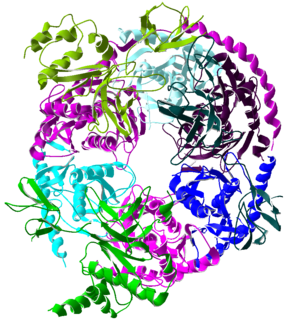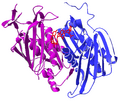Exosome complex facts for kids
The exosome complex is like a special recycling team inside our cells. It's a group of proteins that work together to break down and recycle RNA strands. Think of RNA as important messages or instructions in a cell. Sometimes, these messages need to be cleaned up or gotten rid of when they are old or damaged. That's where the exosome complex comes in!
In complex cells, like the ones in your body (called eukaryotic cells), you can find the exosome complex in different places. It's in the cytoplasm (the jelly-like substance filling the cell), the nucleus (the cell's control center), and especially in the nucleolus (a small part inside the nucleus).
The main part of the exosome complex looks like a ring. This ring is made of six proteins that are all part of a family called 'RNase PH-like proteins'. These are special proteins that can break down RNA.
You can find exosome complexes in eukaryotic cells and also in tiny, ancient life forms called archaea. In bacteria, which are simpler single-celled organisms, there's a similar but simpler team called the degradosome that does a similar recycling job.
Contents
What Does the Exosome Complex Do?
The main job of the exosome complex is to break down RNA molecules. This process is super important for many reasons:
- Quality Control: It helps get rid of faulty or damaged RNA. This stops the cell from making mistakes.
- Controlling Gene Expression: It helps control which genes are active. By breaking down certain RNA messages, the cell can turn off specific instructions.
- Recycling: When RNA is broken down, its building blocks can be reused. This saves energy and resources for the cell.
The exosome complex usually breaks down RNA from one end, like a zipper being unzipped. It can do this in two main ways:
- Hydrolytic Degradation: This method uses water to break the bonds in the RNA.
- Phosphorolytic Degradation: This method uses a phosphate molecule to break the bonds.
Where Are Exosome Complexes Found?
Exosome complexes are found in almost all living things, from the smallest single-celled organisms to complex animals and plants.
- Eukaryotic Cells: In cells like ours, exosomes are found in the nucleus and the cytoplasm. They play different roles in each location. For example, in the nucleus, they help process and clean up RNA that will become proteins. In the cytoplasm, they help control how long certain RNA messages last.
- Archaea: These are tiny, ancient microbes. Their exosome complexes are simpler than ours but still do the same basic job of RNA recycling.
- Bacteria: Instead of an exosome, bacteria have a similar complex called the degradosome. This shows that RNA recycling is a very old and important process for all life.
How Does the Exosome Work?
The exosome complex is made of many different protein parts, called subunits. These subunits work together like a team.
- The Core: The central part of the exosome is a ring-shaped structure. This core helps to hold the RNA molecule in place.
- Active Subunits: Some parts of the exosome complex have "catalytic activity." This means they are the ones that actually do the work of breaking down the RNA. They have special shapes that allow them to grab onto RNA and snip it into smaller pieces.
- Helper Proteins: The exosome often works with other helper proteins. These helpers can guide the RNA to the exosome or prepare it for breakdown.
Understanding the exosome complex helps scientists learn more about how our cells work. It can also help them understand diseases that happen when this recycling system doesn't work correctly.
Images for kids
-
Top and side view of the crystal structure of the human exosome complex.
See also
 In Spanish: Complejo exosoma para niños
In Spanish: Complejo exosoma para niños







